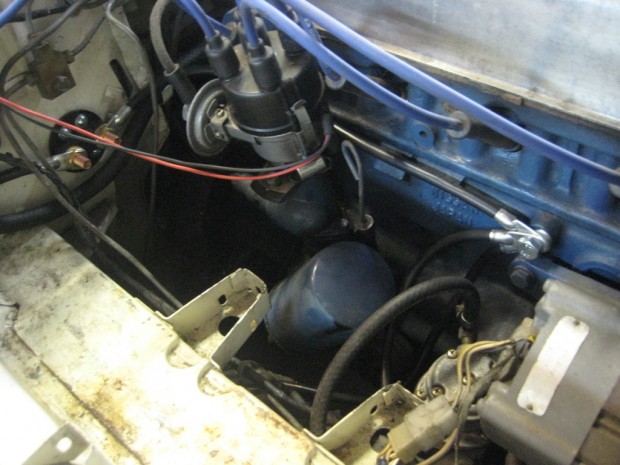
My daughter bounces out of bed somewhere between 5:45 and 6:15 AM with a “Daddy, I wake up!”. On the other end of the baby monitor, I usually just roll over and hope she’ll go back to sleep. The new project car, “Scraps” is also in need of a wake up call. It has not run in over a year, and it was making some strange noises at that time.
The wiring was in bad shape, the positive cable from the battery to the starter was falling apart, the negative lead went from the battery directly to the head (odd, but I guess it makes sense, you want the spark plugs to ground well so they will fire) and the usual ground wires that go missing on these cars over the years had indeed gone missing.
I’m a big fan of battery cutoff switches – I had the simple twist-knob type on my ’69 2000. I would always disconnect the battery when the car was parked. Not so much as an anti-theft measure (having a manual choke and a manual transmission means that 80% of Americans can’t drive they car anyway…) but it really helps the battery to live a long life and gives me peace of mind that some strange short is going to burn the car down.
Popping the hood and installing and removing the knob was a bit of a pain, so a more convenient switch went on the shopping list, along with a new battery, new positive and negative cables and ground leads, new oil and filter as well a fresh set of NGK sparkplugs. (Who puts Autolites in anything other than a Ford? The dread PO – previous owner.)
I got the battery and cables at a local three shop “chain” – United Battery. Looks like they make the cables themselves and seemed to be pretty good quality.

I decided to mount the switch in the passenger footwell, where it can be reached from inside the car and is still somewhat hidden. The wiring also stays on the engine side of the firewall which makes for easy hookup. When it came to wiring it up I ran into a bit of a debate – whether the switch should be on the negative or positive side of the battery. The sports car guys all said “negative” and the racers said “positive”.

After much research, I think I figured out the reason behind the debate: it depends on how you plan to use the switch. If you are using it as a “kill switch” it has to be on the positive side (and must also be able to ground out the alternator – otherwise the motor will keep running even when the switch is off!). A simple “cutoff switch” that keeps the battery from draining belongs on the negative side and is safer – if the switch fails or you short the connectors, you are simply connecting the ground. For my needs, I wired the switch on the negative side – the lead from the battery goes to the switch and another goes from the switch to the block.

I’m a bit obsessive when it comes to grounds – you can almost never have enough – and you can see that I went to great lengths to make sure the common ground on the block was also connected to the frame and the body – as well as the external voltage regulator. (The H20 has an extra set of tapped holes in the block above the alternator mount – perfect for grounds.) I also added one from the block to the head (not shown), and I’m thinking about another to the alternator body. One that is often overlooked is the ground from the starter to the frame. It usually ends up being one of those “left over pieces” after a starter swap.

So all ready to go? I filled the carb float bowls and the stock glass fuel filter with gas, turned the cutoff switch, then the key. WRRRRRR WRRRRR. A really nasty grinding noise – not good. I sounded like the engine might be seized. I took out the plugs and it turned over better, but still sounded like hell. So not seized, but not sounding good.
Time to investigate the starter. On a roadster, the starter, intake, exhaust (and on later cars the alternator as well!) are all on the same side. As you can see in the photo above, if you remove a small triangle of bodywork, you have much better access to the starter and can remove it without removing the carbs and intake (another knuckle skinner as there is no way to get at a few of the bolts with adult human hands….). At some point I’ll have to clean up the chop job that was done sometime in the last 40 years

Seems the starter managed to chew itself up – the aluminum nose was brittle and crumbly. I found an ATK Motors sticker hidden behind the old starter. Not sure if the engine came from a forklift or an Urvan or Homy, but the starter is different from the roadster. Back to United Battery for a 2-hour-turnaround $50 starter rebuild!
So try number two. Lots of cranking, no starting. Right about now is when I decide that it might be good to hook the choke back up and put in some fresh gas. I drain the tank and run to the station for a few gallons of the good stuff. Which brings us to attempt number three:
It runs! There is definitely a hole in the exhaust manifold, and a stray lock washer did a bit of a dance with the radiator fan (twice!), but it runs. The fresh gas and the use of the choke did the trick. I was later told that this car is a bit cold-blooded and wants choke even on the warmest day – actually a good sign that the carbs are well adjusted.





2 Responses to Wake Up Call